A Self-Optimizing Technique Based on Vertical Handover for Load Balancing in Heterogeneous Wireless Networks Using Big Data Analytics
Abstract
:1. Introduction
1.1. Background and Problem Statement
1.2. Motivation
1.3. Our Contributions
- The problem of ensuring the effective functioning of a heterogeneous radio access network is formalized;
- The method of increasing the efficiency of functioning of heterogeneous mobile communication networks based on big data technology is developed;
- The realization of technologies for processing big data volumes, obtained by simulating the process of functioning of a heterogeneous network is carried out;
- The assessment of the effectiveness of the proposed solutions in relation to the optimization problem of the resources of a heterogeneous network of mobile communication is carried out.
2. Related Work
3. Proposed Solution
3.1. A Future Generation Heterogeneous Wireless Network Based on Big Data Analytics
- The network may redirect the UE to another network that has sufficient capacity to process its current communications;
- The network can also coordinate the mobility of all UEs so that total traffic is evenly distributed across all resources, congestion is minimized, and total bandwidth is maximized.
3.2. Radio Access Network Selection Optimization in Heterogeneous Wireless Networks
- Conditions on the mobile device side are required, that is, a number of conditions, constraints, and criteria are imposed on the choice of devices to perform and assign work operations. We denote all these requirements by the following:where g is the total number of requirements and conditions, the value of which is determined by the task setter; Vi is the i-th requirement determined by the operator.
- A number of requirements are imposed on the quality of functioning of a work operation:where h is the number of requirements and performance criteria (support for the process of performing and the result of performing a work operation). The value of h (the number of requirements and criteria) is determined by the problem setter. Wi are the requirements for the execution of a work operation: responsiveness, minimum cost, and so on.
3.3. A Self-Optimizing Technique Based on Vertical Handover for Load Balancing in HWN Using BD Analytics
- Calls as voice transmission over IP networks (Voice over IP);
- Digital Interactive Television (IPTV);
- Internet data (I), which includes uploading and downloading data from internet resources;
- Video conferencing (Conf);
- WEB.
- Throughputs (C);
- Probability of losses (Pv);
- Delay time (T);
- Jitter (dt).
4. Experimental Results
- Dynamic reservation of the number of sessions, which allows to evenly distribute the load from users (proposed method 1);
- Rejection of non-priority sessions to provide guaranteed quality of service to priority users (proposed method 2).
5. Conclusions
Author Contributions
Funding
Institutional Review Board Statement
Informed Consent Statement
Data Availability Statement
Conflicts of Interest
References
- Bai, W.; Xiao, Y.; Hu, D.; Zhang, Y. Application Research of Multi-Mode Relay in Future Heterogeneous Networks. Appl. Sci. 2019, 9, 3934. [Google Scholar] [CrossRef] [Green Version]
- Zhang, H.; Huang, C.; Zhou, J.; Chen, L. QoS-Aware Virtualization Resource Management Mechanism in 5G Backhaul Het-erogeneous Networks. IEEE Access 2020, 8, 19479–19489. [Google Scholar] [CrossRef]
- Chettri, L.; Bera, R. A Comprehensive Survey on Internet of Things (IoT) Toward 5G Wireless Systems. IEEE Internet Things J. 2020, 7, 16–32. [Google Scholar] [CrossRef]
- Chen, M.; Ullah, S.; Wang, L.; Chen, J.; Wei, X.; Kim, K.; Xu, J. Analysis and Scheduling in a 5G Heterogeneous Content De-livery Network. IEEE Access 2018, 6, 44803–44814. [Google Scholar] [CrossRef]
- Beshley, M.; Kryvinska, N.; Seliuchenko, M.; Beshley, H.; Shakshuki, E.M.; Yasar, A.-U.-H. End-to-End QoS “Smart Queue” Management Algorithms and Traffic Prioritization Mechanisms for Narrow-Band Internet of Things Services in 4G/5G Net-works. Sensors 2020, 20, 2324. [Google Scholar] [CrossRef] [Green Version]
- Asghari, M.; Yousefi, S.; Niyato, D. An Analysis of Service Bundles of Mobile Network Operators with Free Services Includ-ed. IEEE Trans. Mob. Comput. 2020, 19, 1789–1803. [Google Scholar]
- Höyhtyä, M.; Lähetkangas, K.; Suomalainen, J.; Hoppari, M.; Kujanpää, K.; Ngo, K.T.; Kippola, T.; Heikkilä, M.; Posti, H.; Mäki, J.; et al. Critical Communications Over Mobile Operators’ Networks: 5G Use Cases Enabled by Licensed Spectrum Sharing, Network Slicing and QoS Control. IEEE Access 2018, 6, 73572–73582. [Google Scholar] [CrossRef]
- Beshley, M.; Veselý, P.; Pryslupskyi, A.; Beshley, H.; Kyryk, M.; Romanchuk, V.; Kahalo, I. Customer-Oriented Quality of Service Management Method for the Future Intent-Based Networking. Appl. Sci. 2020, 10, 8223. [Google Scholar] [CrossRef]
- Klymash, M.; Beshley, M.; Stryhaluk, B. System for Increasing Quality of Service of Multimedia Data in Convergent Net-works. In Proceedings of the 2014 First International Scientific-Practical Conference Problems of Infocommunications Science and Technology, Kharkov, Ukraine, 22 December 2014; pp. 63–66. [Google Scholar]
- Luján, E.; Zuloaga Mellino, J.A.; Otero, A.D.; Vega, L.R.; Galarza, C.G.; Mocskos, E.E. Extreme Coverage in 5G Narrow-band IoT: A LUT-Based Strategy to Optimize Shared Channels. IEEE Internet Things J. 2020, 7, 2129–2136. [Google Scholar] [CrossRef]
- Al-Shammari, B.K.J.; Al-Aboody, N.; Al-Raweshidy, H.S. IoT Traffic Management and Integration in the QoS Supported Network. IEEE Internet Things J. 2018, 5, 352–370. [Google Scholar] [CrossRef] [Green Version]
- Demydov, I.; Seliuchenko, M.; Beshley, M.; Brych, M. Mobility Management and Vertical Handover Decision in an Always Best Connected Heterogeneous Network. In Proceedings of the Experience of Designing and Application of CAD Systems in Microelectronics, Lvi, Ukraine, 24–27 February 2015; pp. 103–105. [Google Scholar]
- He, Y.; Yu, F.R.; Zhao, N.; Yin, H.; Yao, H.; Qiu, R.C. Big Data Analytics in Mobile Cellular Networks. IEEE Access 2016, 4, 1985–1996. [Google Scholar] [CrossRef]
- Goudarzi, M. Heterogeneous Architectures for Big Data Batch Processing in MapReduce Paradigm. IEEE Trans. Big Data 2017, 5, 18–33. [Google Scholar] [CrossRef]
- Zhang, L.; Shi, Y.; Chang, Y.-C.; Lin, C.-T. Hierarchical Fuzzy Neural Networks With Privacy Preservation for Heterogeneous Big Data. IEEE Trans. Fuzzy Syst. 2020, 29, 46–58. [Google Scholar] [CrossRef]
- Ma, B.; Guo, W.; Zhang, J. A Survey of Online Data-Driven Proactive 5G Network Optimisation Using Machine Learning. IEEE Access 2020, 8, 35606–35637. [Google Scholar] [CrossRef]
- Shao, G.; Wu, W.; Yin, L.; Ding, C. A Load Balancing Vertical Handoff Algorithm Considering QoS of Users for Heterogene-ous Networks in Power Communication. J. Phys. Conf. Ser. 2019, 1302, 022099. [Google Scholar] [CrossRef]
- Su, D.; Wen, X.; Zhang, H.; Zheng, W. A Self-optimizing Mobility Management Scheme Based on Cell ID Information in High Velocity Environment. In Proceedings of the IEEE Second International Conference on Computer and Network Technology, Bangkok, Thailand, 23–25 April 2010; pp. 285–288. [Google Scholar]
- Saeed, M.; Kamal, H.; El-Ghoneimy, M. Novel type-2 fuzzy logic technique for handover problems in a heterogeneous network. Eng. Optim. 2017, 50, 1533–1543. [Google Scholar] [CrossRef]
- Alhabo, M.; Zhang, L. Multi-Criteria Handover Using Modified Weighted TOPSIS Methods for Heterogeneous Networks. IEEE Access 2018, 6, 40547–40558. [Google Scholar] [CrossRef]
- Martinez-Mosquera, D.; Navarrete, R.; Luján-Mora, S. Development and Evaluation of a Big Data Framework for Perfor-mance Management in Mobile Networks. IEEE Access 2020, 8, 226380–226396. [Google Scholar] [CrossRef]
- Biswash, S.K.; Jayakody, D.N.K. A Fog Computing-Based Device-Driven Mobility Management Scheme for 5G Net-works. Sensors 2020, 20, 6017. [Google Scholar] [CrossRef]
- Sultan, K.; Ali, H.; Zhang, Z. Big Data Perspective and Challenges in Next Generation Networks. Future Internet 2018, 10, 56. [Google Scholar] [CrossRef] [Green Version]
- Qu, K.; Zhuang, W.; Ye, Q.; Shen, X.; Li, X.; Rao, J. Dynamic Flow Migration for Embedded Services in SDN/NFV-Enabled 5G Core Networks. IEEE Trans. Commun. 2020, 68, 2394–2408. [Google Scholar] [CrossRef]
- Beshley, M.; Pryslupskyi, A.; Panchenko, O.; Beshley, H. SDN/Cloud Solutions for Intent-Based Networking. In Proceedings of the 2019 3rd International Conference on Advanced Information and Communications Technologies (AICT), Lviv, Ukraine, 2–6 July 2019; pp. 22–25. [Google Scholar]
- Klymash, M.; Savchuk, R.; Pozdnyakov, P.; Beshley, M. The Researching and Modeling of Structures of Mobile Networks for Providing of Multiservice Radio Access. In Proceedings of the International Conference on Modern Problem of Radio Engi-neering, Telecommunications and Computer Science (TCSET), Lviv-Slavske, Ukraine, 21–24 February 2012; pp. 281–282. [Google Scholar]
- Beshley, M.; Romanchuk, V.; Seliuchenko, M.; Masiuk, A. Investigation the Modified Priority Queuing Method Based on Vir-tualized Network Test Bed. In Proceedings of the Experience of Designing and Application of CAD Systems in Mi-croe-lectronics, Lviv, Ukraine, 24–27 February 2015; pp. 1–4. [Google Scholar]
- Barona López, L.I.; Valdivieso Caraguay, Á.L.; Sotelo Monge, M.A.; García Villalba, L.J. Key Technologies in the Context of Future Networks: Operational and Management Requirements. Future Internet 2017, 9, 1. [Google Scholar] [CrossRef] [Green Version]
- Fan, S.; Tian, H.; Wang, W. A Radio Resource Virtualization-Based RAT Selection Scheme in Heterogeneous Networks. IEEE Commun. Lett. 2017, 21, 1147–1150. [Google Scholar] [CrossRef]
- El Helou, M.; Ibrahim, M.; Lahoud, S.; Khawam, K.; Mezher, D.; Cousin, B. A Network-Assisted Approach for RAT Selection in Heterogeneous Cellular Networks. IEEE J. Sel. Areas Commun. 2015, 33, 1055–1067. [Google Scholar] [CrossRef] [Green Version]
- Habibi, M.A.; Nasimi, M.; Han, B.; Schotten, H.D. A Comprehensive Survey of RAN Architectures Toward 5G Mobile Communication System. IEEE Access 2019, 7, 70371–70421. [Google Scholar] [CrossRef]
- Bazzi, A.; Masini, B.M.; Zanella, A.; Dardari, D. Performance evaluation of softer vertical handovers in multiuser heterogeneous wireless networks. Wirel. Netw. 2017, 23, 159–176. [Google Scholar] [CrossRef]
- Zheng, K.; Yang, Z.; Zhang, K.; Chatzimisios, P.; Yang, K.; Xiang, W. Big data-driven optimization for mobile networks toward 5G. IEEE Netw. 2016, 30, 44–51. [Google Scholar] [CrossRef]
- Garcia-Pineda, M.; Felici-Castell, S.; Segura-Garcia, J. Using Factor Analysis Techniques to Find Out Objective Video Quality Metrics for Live Video Streaming over Cloud Mobile Media Services. Netw. Protoc. Algorithms 2016, 8, 126–147. [Google Scholar] [CrossRef] [Green Version]
- Ishteyaq, I.; Masoodi, I.S.; Muzaffar, K. Six-Element MIMO Antenna with Slot Ring Radiators for Future 5G Hand-Held Mo-bile Applications. In Proceedings of the 2020 IEEE Bangalore Humanitarian Technology Conference (B-HTC), Vijiyapur, India, 8–10 October 2020; pp. 1–4. [Google Scholar]
- Hadoop, Storm, Samza, Spark, and Flink: Big Data Frameworks Compared. Available online: https://www.digitalocean.com/community/tutorials/hadoop-storm-samza-spark-and-flink-big-data-frameworks-compared (accessed on 18 March 2021).
- Mockaroo—Random Data Generator and API Mocking Tool|JSON/CSV/SQL/Excel. Available online: https://www.mockaroo.com/ (accessed on 18 March 2021).


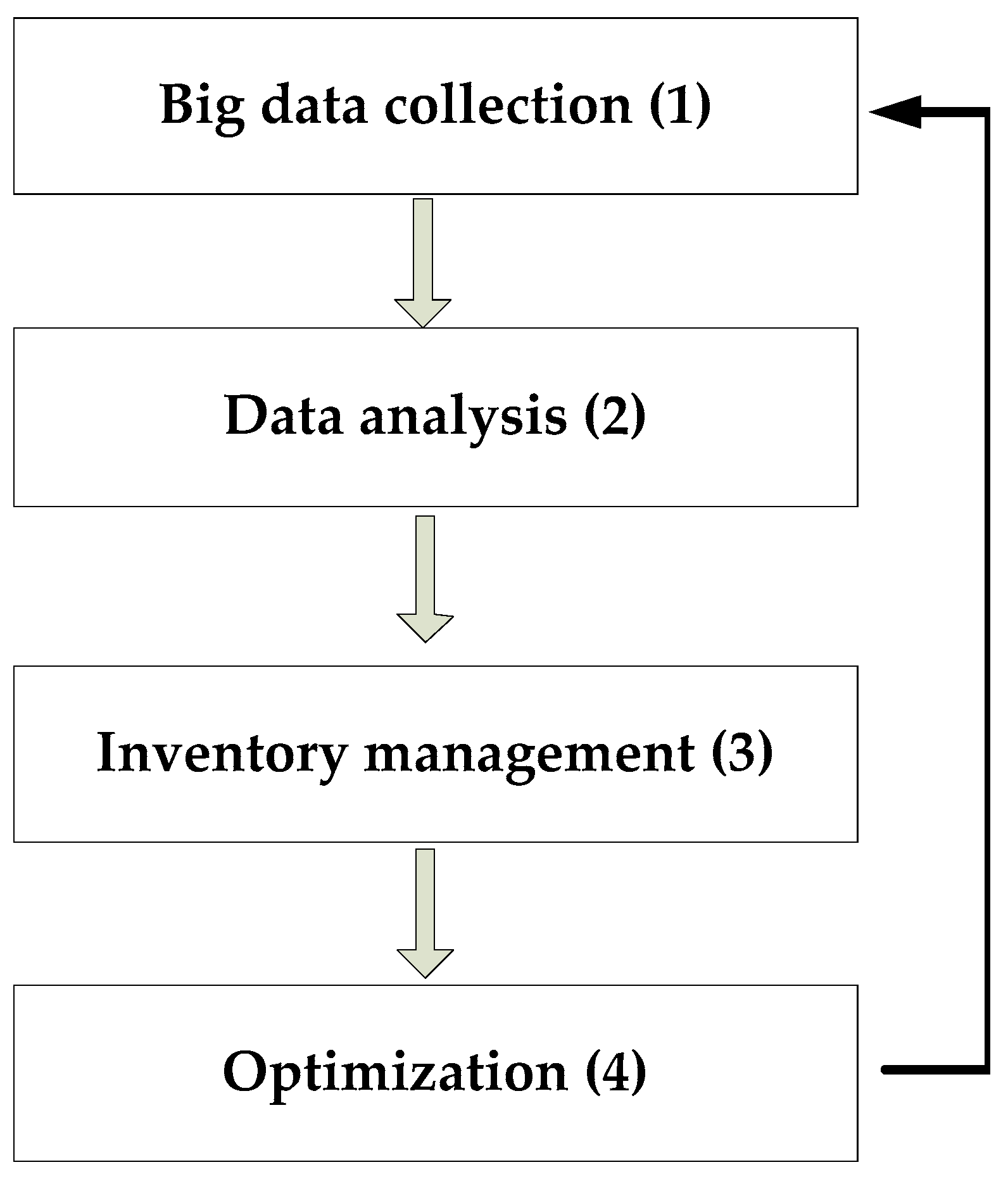
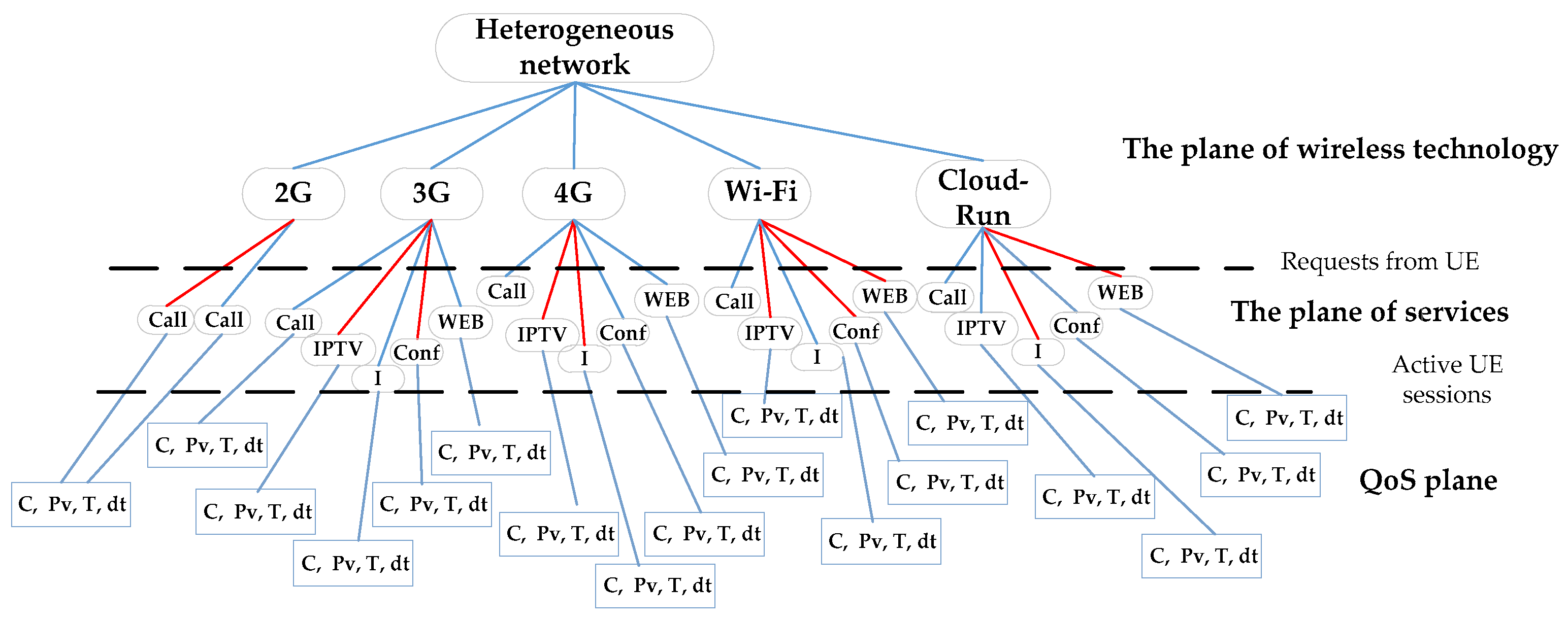

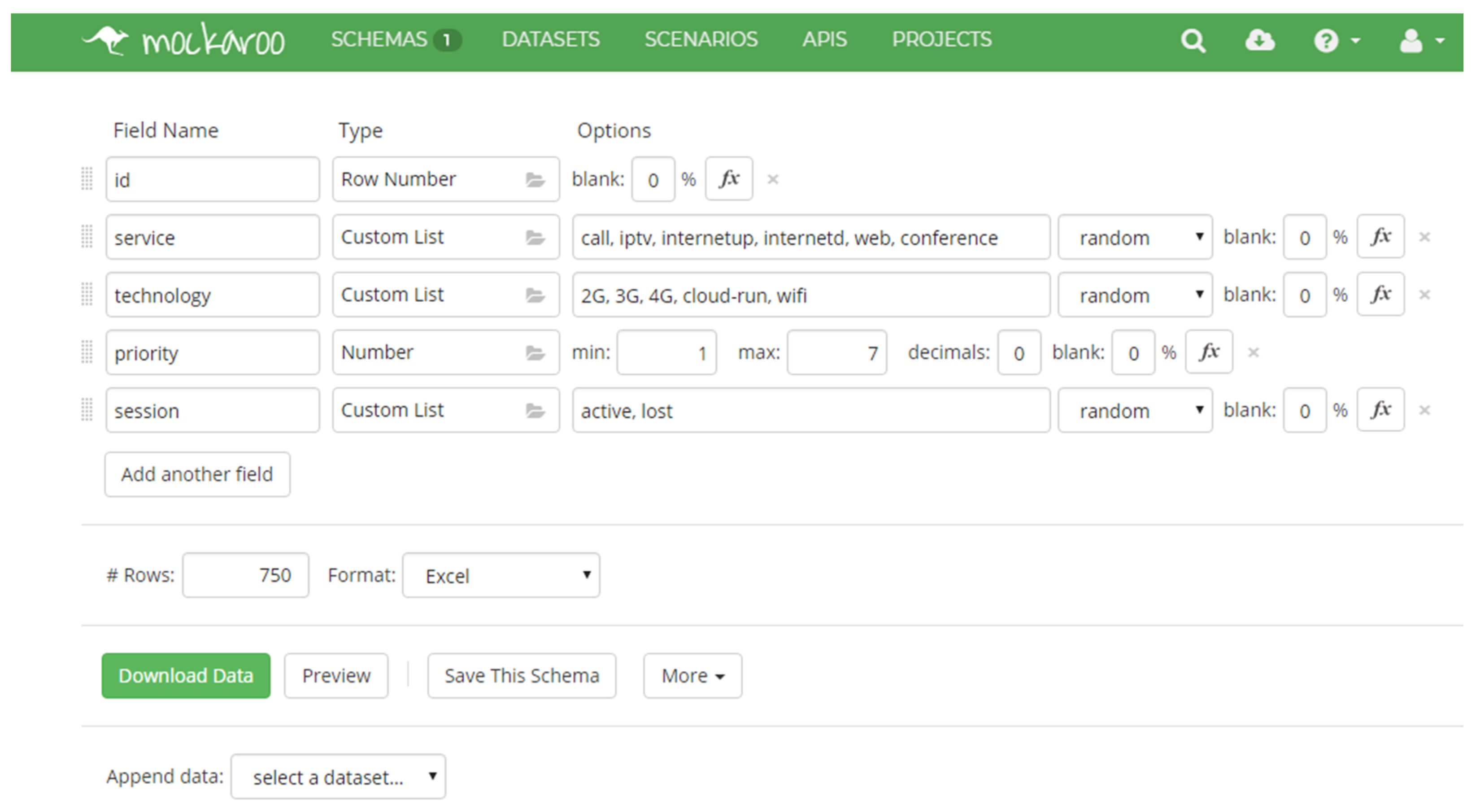
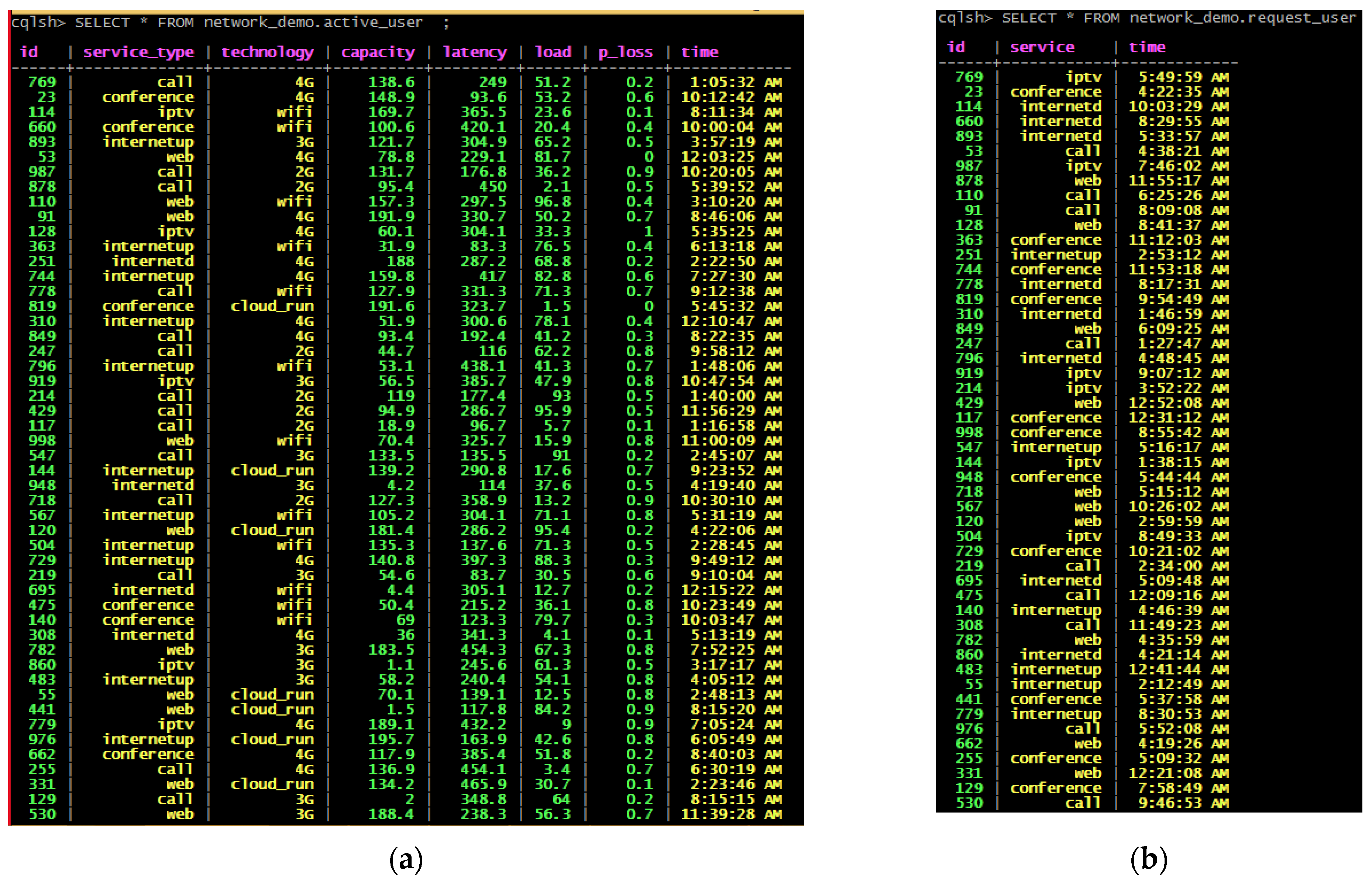

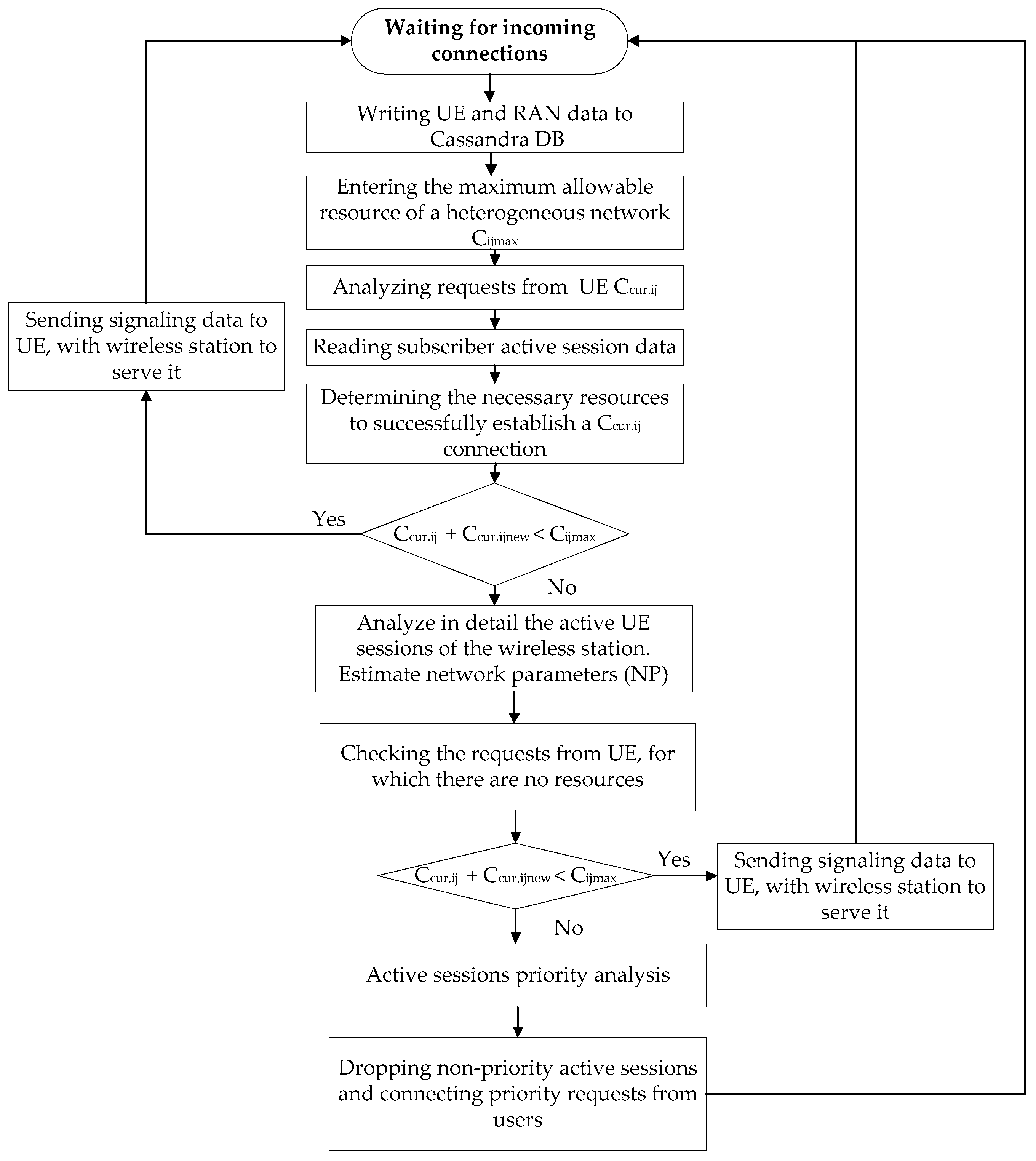
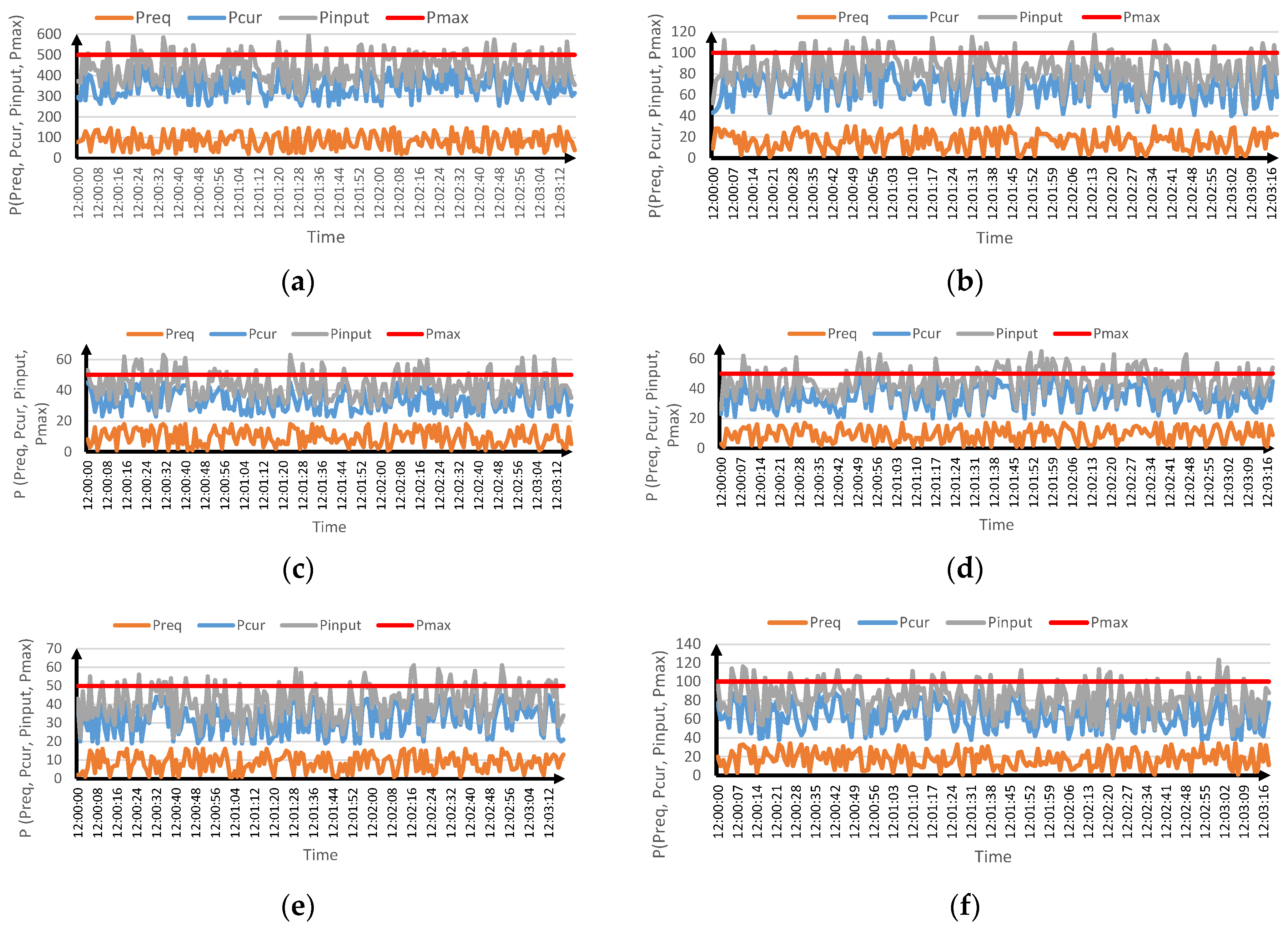
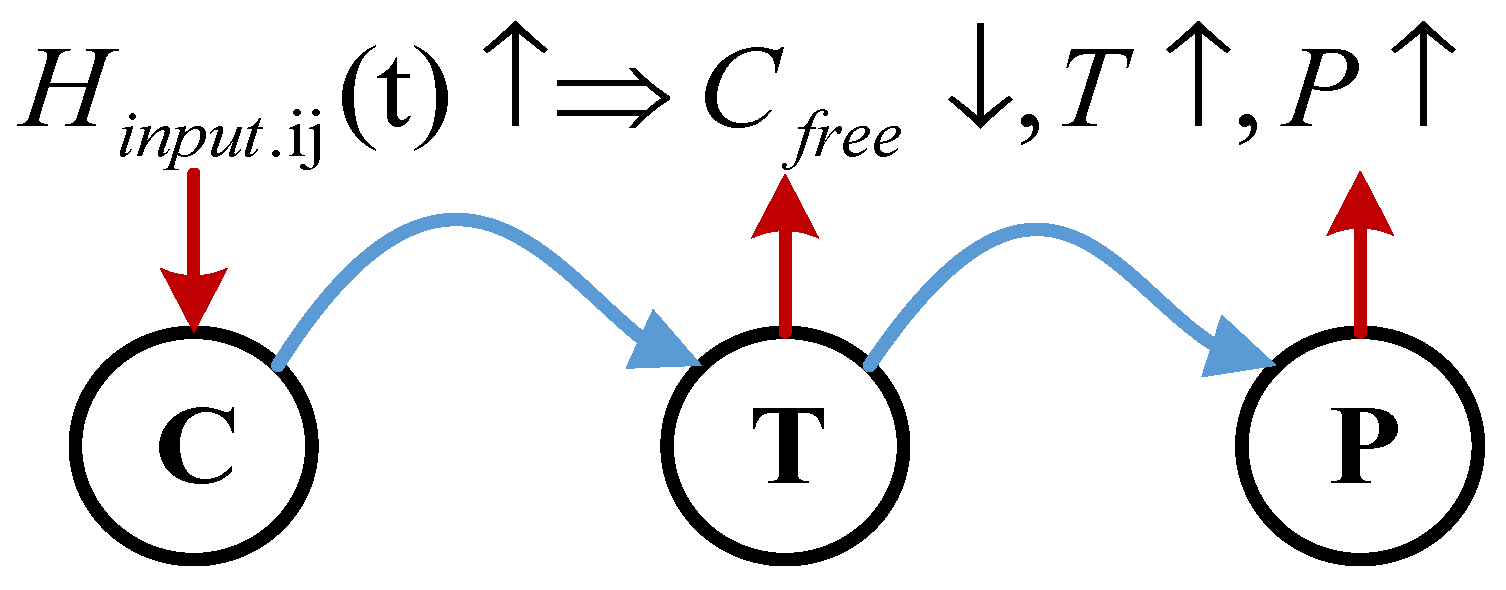
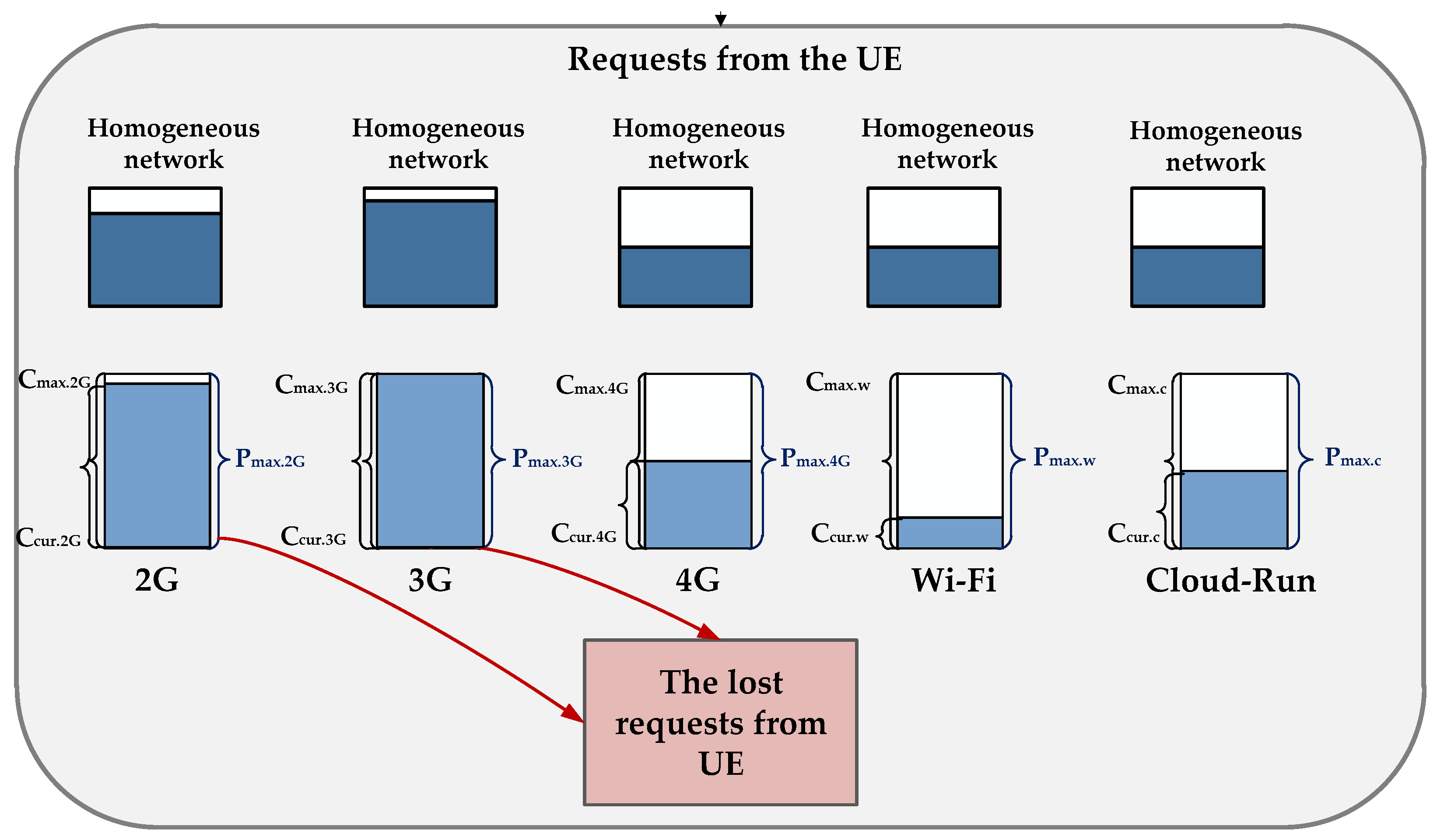

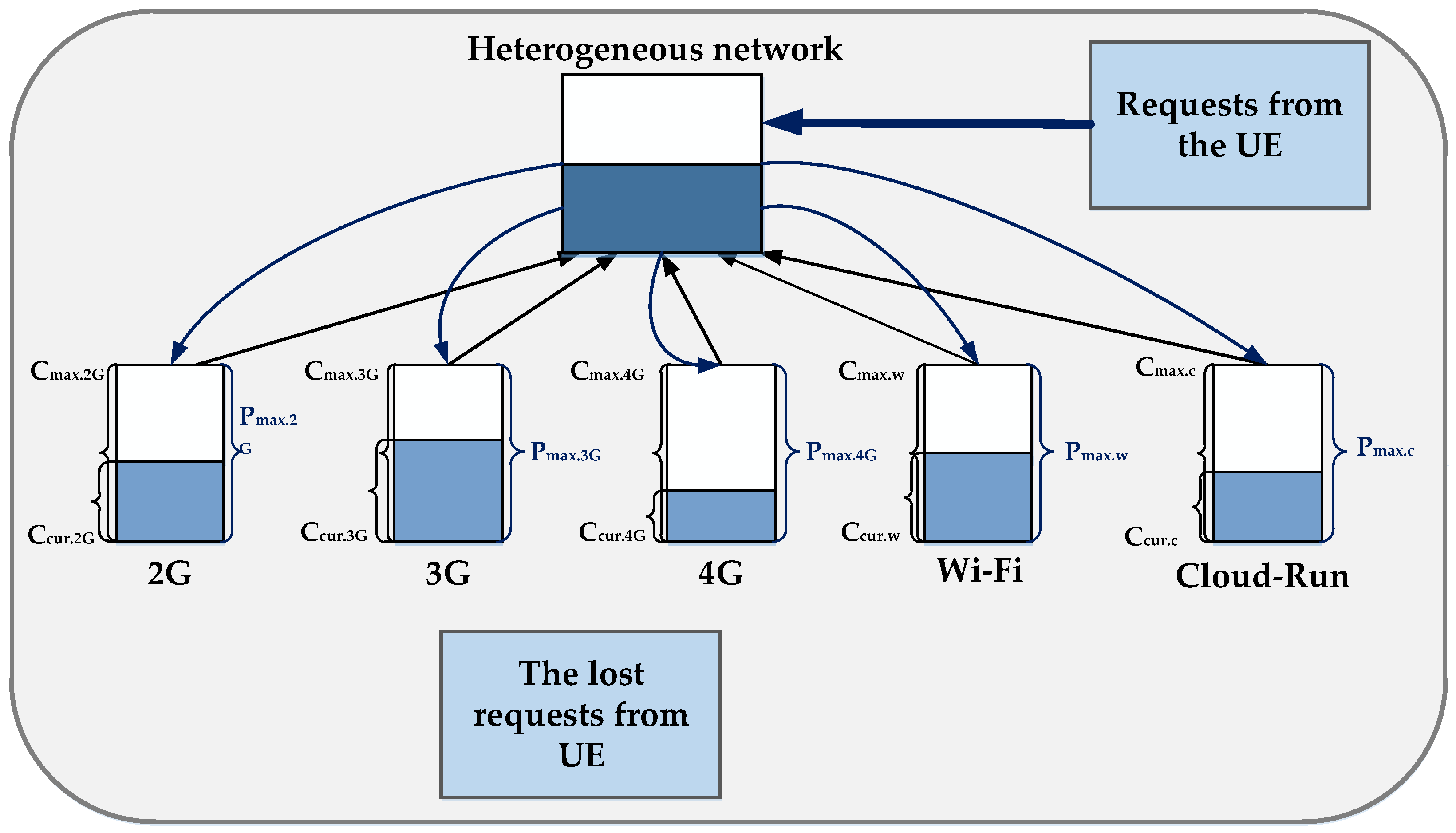

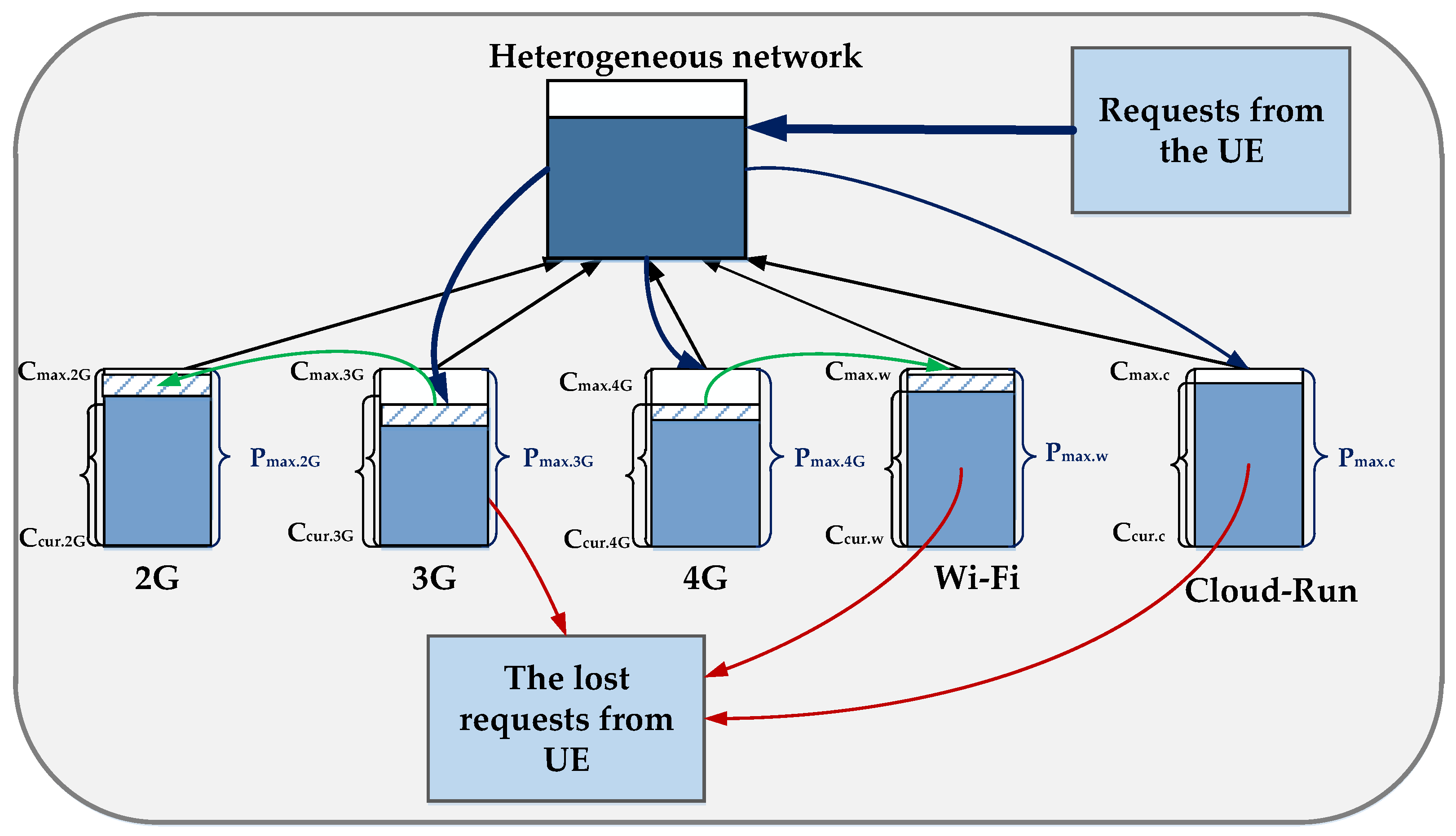

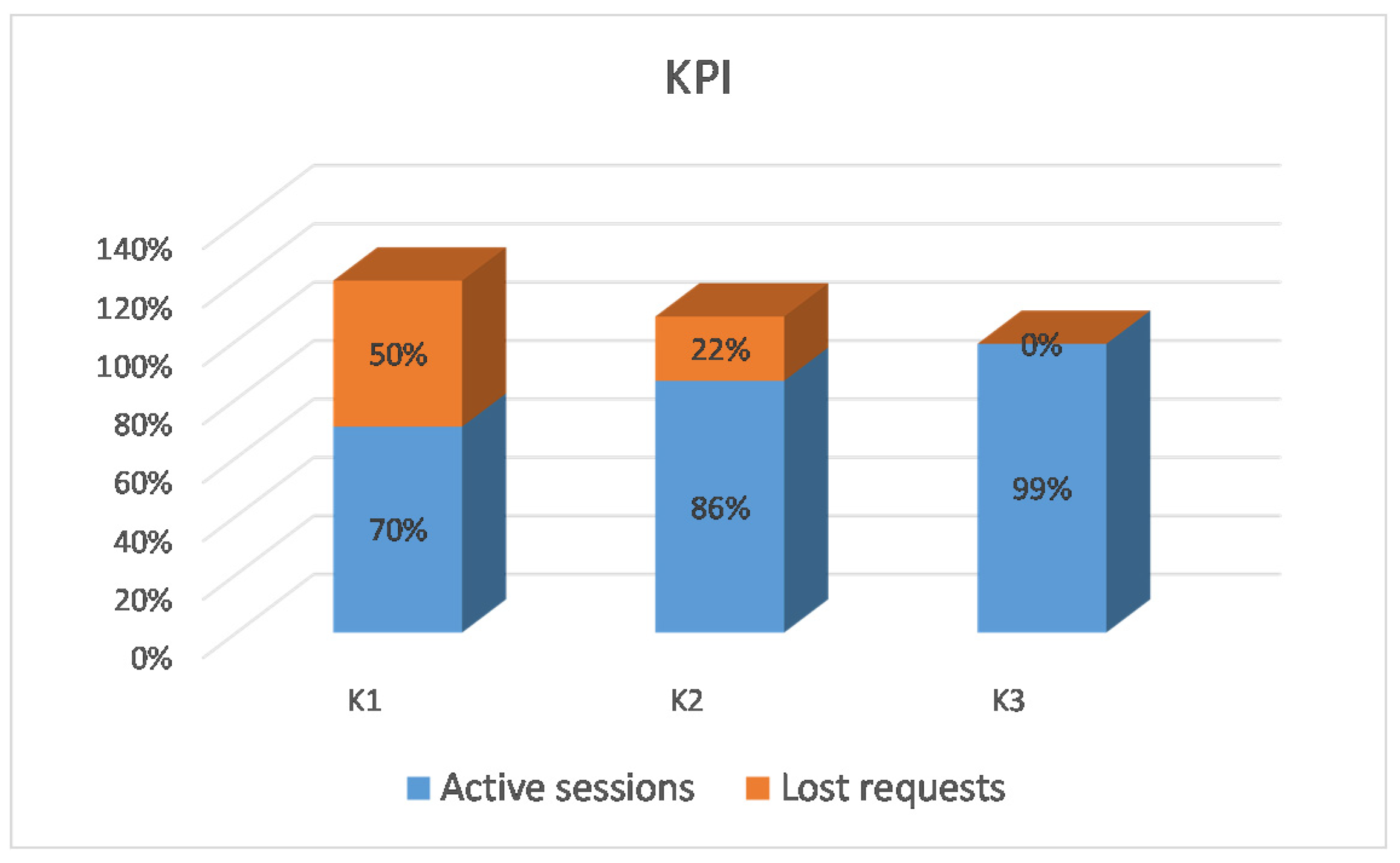

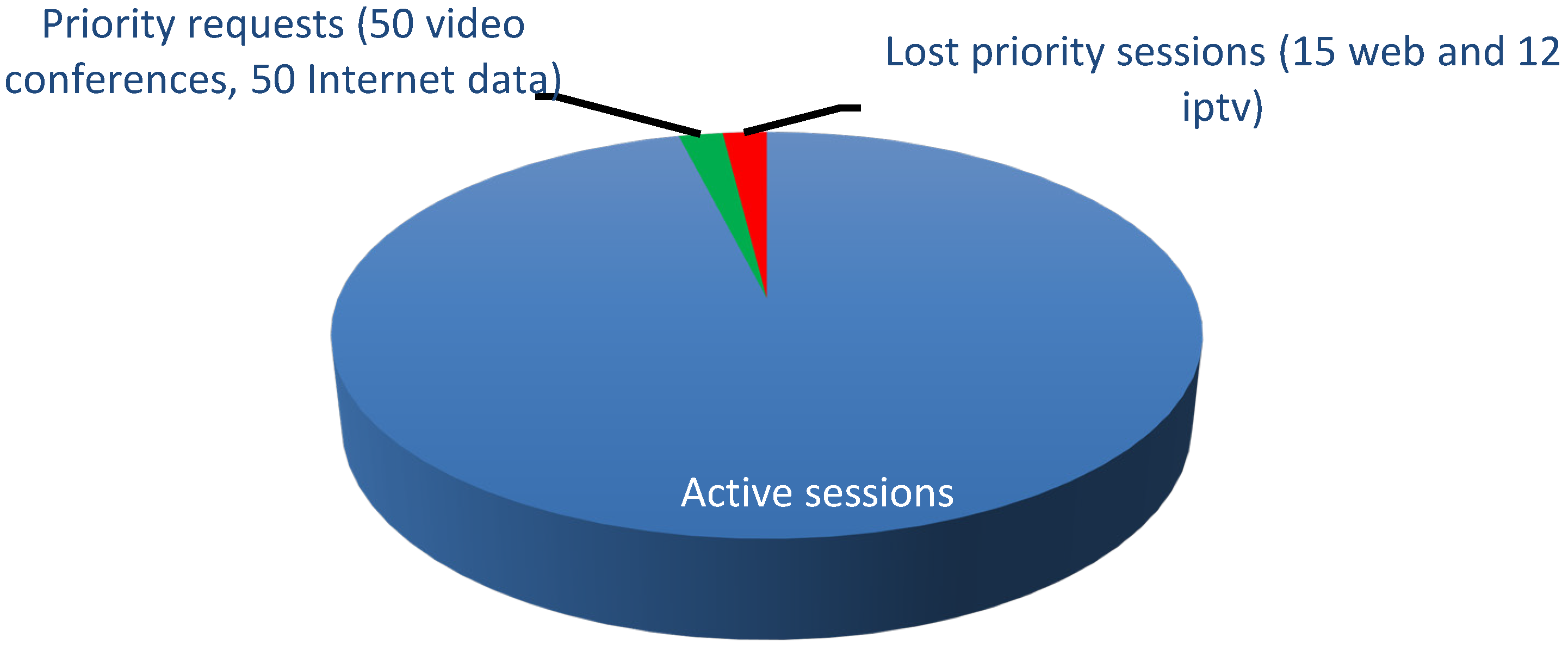
| Technology/Service | 2G | 3G | 4G | Wi-Fi | Cloud-RAN |
|---|---|---|---|---|---|
| Call | 1000 | 500 | 500 | 200 | 500 |
| Conference | 0 | 100 | 200 | 150 | 400 |
| IPTV | 0 | 50 | 100 | 150 | 200 |
| Web | 0 | 50 | 100 | 100 | 200 |
| Internet (download) | 0 | 50 | 100 | 150 | 200 |
| Internet (upload) | 0 | 100 | 200 | 250 | 400 |
| Service | Throughput (kbps) |
|---|---|
| Call | 64 |
| Conference | 2048 |
| IPTV | 4096 |
| Web | 10,240 |
| Internet (download) | 2048 |
| Internet (upload) | 2048 |
Publisher’s Note: MDPI stays neutral with regard to jurisdictional claims in published maps and institutional affiliations. |
© 2021 by the authors. Licensee MDPI, Basel, Switzerland. This article is an open access article distributed under the terms and conditions of the Creative Commons Attribution (CC BY) license (https://creativecommons.org/licenses/by/4.0/).
Share and Cite
Beshley, M.; Kryvinska, N.; Yaremko, O.; Beshley, H. A Self-Optimizing Technique Based on Vertical Handover for Load Balancing in Heterogeneous Wireless Networks Using Big Data Analytics. Appl. Sci. 2021, 11, 4737. https://doi.org/10.3390/app11114737
Beshley M, Kryvinska N, Yaremko O, Beshley H. A Self-Optimizing Technique Based on Vertical Handover for Load Balancing in Heterogeneous Wireless Networks Using Big Data Analytics. Applied Sciences. 2021; 11(11):4737. https://doi.org/10.3390/app11114737
Chicago/Turabian StyleBeshley, Mykola, Natalia Kryvinska, Oleg Yaremko, and Halyna Beshley. 2021. "A Self-Optimizing Technique Based on Vertical Handover for Load Balancing in Heterogeneous Wireless Networks Using Big Data Analytics" Applied Sciences 11, no. 11: 4737. https://doi.org/10.3390/app11114737
APA StyleBeshley, M., Kryvinska, N., Yaremko, O., & Beshley, H. (2021). A Self-Optimizing Technique Based on Vertical Handover for Load Balancing in Heterogeneous Wireless Networks Using Big Data Analytics. Applied Sciences, 11(11), 4737. https://doi.org/10.3390/app11114737






